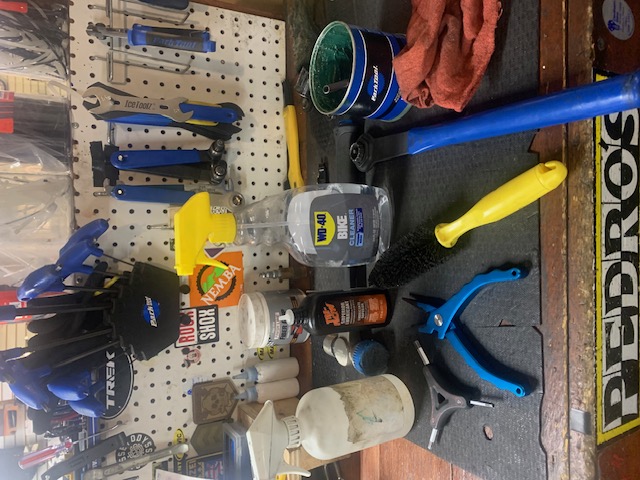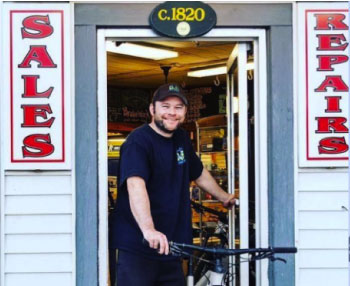What Is A Bike Tune Up?

Taking care of your bicycle is essential to ensure a smooth and safe ride. One of the most important maintenance tasks is a regular tune-up.
A bike tune-up involves a series of steps that help keep your bike in top condition and prevent any potential issues. Think of it like an oil change for your car.
In this article we break down what's involved in a bike tune up, why bikes need them, and how to tell when it's time to tune up your bike.
Keep reading to learn everything you need to know!

By: Matt Donovan,
3rd generation Owner and General Manager of Dedham Bike
Last updated: 1/30/2024
Why bikes need tune ups
Regular bike maintenance offers crucial advantages like ensuring rider safety, enhancing cycling performance, and extending the lifespan of bike components.
Increased Safety
Regular maintenance checks are vital for identifying wear and tear or potential failures that could lead to accidents. For instance, checking brake pads and cables for wear and ensuring they're properly adjusted can prevent brake failure, a common safety hazard.
Better Performance
A well-tuned bike delivers a smoother ride. Factors such as tire pressure and lubricated drivetrains play a significant role in reducing riding effort and enhancing speed and agility.
Longevity of Bike Parts
Consistent tune-ups and care can drastically prolong the life of a bicycle's parts. By adequately cleaning and lubricating the components, one can avoid the premature wear that often leads to replacements and costly repairs.
How to tell when your bike needs a tune up
Difficulty Shifting Gears
When a bike struggles to shift gears smoothly, it could indicate stretched cables or a misaligned derailleur. These issues result in a less responsive ride and may lead to the need for a tune up.
Unusual Noises
A well-maintained bike operates quietly. If one starts to hear clicking, grinding, or knocking sounds, these noises might point to loose components or the need for cleaning and lubrication, signaling it's time to consider servicing the bike.
Poor Brake Performance
If brakes feel spongy or are less effective, it's time to inspect them. Brake pads wear out with use, and cables may stretch or fray, compromising safety. Make sure to inspect these components for any signs indicating a compromised braking system.
Visible Wear and Tear
Regular visual inspections can reveal issues such as rust, worn tires, or frayed cables. If the bike has been neglected, these become evident and are clear signs that the bike inevitably requires a tune up.
How often do bikes need tune ups?
Regular maintenance of a bicycle ensures safety, performance, and longevity. The frequency of tune-ups largely depends on usage, riding conditions, and time of year.
Regular Use Intervals
For cyclists who ride frequently, it's recommended to have a bike tune-up at least twice a year. According to many experts including ourselvesI, this helps maintain complex components like spokes and bearing surfaces. Those who clock in more than 2,000 miles annually may require more frequent tune-ups.
Event-Based Maintenance
Bicycles that exhibit signs of wear or issues such as strange noises, decreased braking efficiency, or gear shifting problems need to be tuned up on an as-needed basis. It's vital to address these issues promptly to prevent accidents and further damage.It's very important to note that if a bike has been in an accident, a tune-up is crucial, regardless of the last service date.
Racing Or Fundraiser Rides
If you're racing your bike, training to race or are planning on doing a fundraiser ride you will want to have your bike tuned for those events. Nothing will ruin your day faster than a bike that was not properly prepped to hold up to the rigors of your event.
Seasonal Considerations
At the change of seasons, especially after wet or winter periods, it's wise to schedule a tune-up to address any issues that harsh conditions may have caused. Components can experience additional stress during these times, making post-season tune-ups an important aspect of bike care. It's hard to emphasize enough the importance of regular checks to prolong the bike's components and overall lifespan.
What does a bike tune up typically include?
We highly suggest a yearly tuning of your bike, even if it's been sitting as sitting can be the worst thing for a bicycle. It allows things to become gummed up which greatly effects how your bike shifts and brakes.
Taking care of your bicycle is essential to ensure a smooth and safe ride. One of the most important maintenance tasks is a regular tune-up. A bike tune-up involves a series of steps that help keep your bike in top condition and prevent any potential issues. In this article, we will outline six essential steps for a perfect tune-up.
Cleaning and Inspection
Remove any dirt and debris from the frame, wheels, and drivetrain (Annual tune gets you the best and deepest cleaning) .
Inspect the frame for any cracks or damage.
Check the wheels for any loose or broken spokes.
Examine the drivetrain for worn-out or damaged components (replace if needed).
Adjusting the Brakes
Check the brake pads for wear and replace if necessary.
Adjust the brake calipers to ensure proper alignment with the rims.
Test the brakes to ensure they engage smoothly and provide sufficient stopping power.
Lubricating the Chain and Cables
Apply lubricant to the chain and wipe off any excess.
Lubricate the cables to ensure smooth shifting and braking.
Check for any signs of rust or corrosion and address them accordingly.
Checking and Adjusting the Gears
Inspect the gears for any signs of wear or damage.
Adjust the derailleur to ensure smooth and precise shifting.
Test the gears in different combinations to ensure they engage properly.
Checking and Inflating the Tires
Inspect the tires for any cuts, punctures, or excessive wear.
Inflate the tires to the recommended pressure.
Check for any signs of bulging or uneven wear and address them accordingly.
Tightening and Adjusting Bolts
Check all bolts and screws on the bike for tightness.
Tighten any loose bolts or screws.
Adjust the handlebars, seat, and pedals to the desired position.
How much does a bike tune up cost?
How much a bike tune up costs depends on several factors, such as how often you ride, how long it's been since your last maintenance, and whether you need to replace components.
At Dedham Bike, our bike tune ups start at $90. Check out our bike repair page to learn more.
If you ride a ton, you might wear out components like tires and chains more quickly than if you ride every now and then.
If your bike has been sitting around in the basement accumulating dust and dirt, it might need more love than if you keep it clean.
When to get a bike tune up from a bike shop
Many of the bike tune up steps can often be done with simple tools like a pump, some lube, a multi tool, and a rag. But there are definitely times when you'll want to consider letting a professional take a look.
For example, your poor shifting might be fixed with some lube, but if your derailleur's limit screws aren't aligned properly it could chuck your chain off the chainring (or worse, into your spokes).
Besides airing up your tires, lubing your chain, and general cleaning, we recommend that if you don't have much experience working on bikes, it's best to let the pros ensure your bike's performance safety when it comes to tune ups.
Personnel are very knowledgeable friendly and helpful. I prefer to go there versus other larger bike shops. They give you personalized treatment here and it’s definitely appreciated. I will always go back to them for any of my biking needs - you can’t go wrong here. - Frank K.
Read More Reviews....
Frequently Asked Questions
This section addresses common inquiries regarding bicycle tune-ups, including the frequency, signs of necessity, cost, and procedures involved.
How often should a bicycle be tuned up to maintain optimal performance?
A bicycle should receive a tune-up at least once a year to maintain optimal performance. However, frequent riders should consider tune-ups more regularly, such as every few months, or after an extended period of heavy use.
What are the indicative signs that a bike requires a tune-up?
Indicative signs that a bike may require a tune-up include unusual noises, such as squeaking, difficulty shifting gears, brakes that are less responsive, and visible wear on parts like brake pads or cables. If riding feels less smooth or more strenuous, a tune-up might be needed.
Can the value of a bike affect the advisability of getting a tune-up?
The value of a bike does not negate the need for regular maintenance. Regardless of a bike's cost, a tune-up can prevent more expensive repairs in the future and ensure a safer, more enjoyable riding experience.
What is the typical cost range for a professional bike tune-up?
The cost for a professional bike tune-up can range in price, depending on the level of service required and the region. Additional repairs or part replacements can increase the total cost.
What maintenance steps are included in a standard bicycle tune-up?
A standard bicycle tune-up typically includes adjusting gears and brakes, lubricating the chain, and checking the tire pressure. It may also involve truing the wheels, inspecting the bottom bracket, headset, hubs, and a thorough frame cleaning. Most shops offer different service levels which come with more or less work done on the bike.
After how many miles should one consider getting a bicycle tuned-up?
It is advisable to consider a bicycle tune-up after every 2,000 to 3,000 miles ridden. However, this can vary based on riding conditions, the type of bike, and the individual's riding style.
My bike has been sitting unused for a while, do I need to get it tuned up?
The short answer is yes, you should get your bike tuned after a period of little or no use. This is because bikes like to be ridden, a bike that sits can get rusty and it's moving parts get gummed up due to sitting. This will effect the shifting and braking of the bike and will generally give the rider a back experience and a possible unsafe bike to ride.
